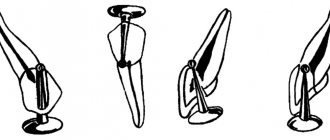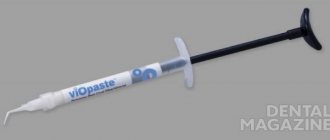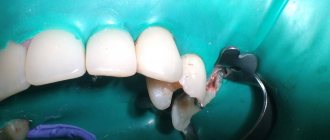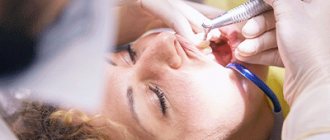Content
- Dental restoration methods
- Dental restoration with pins
- Dental restoration with inlays
- Dental restoration with crowns
The success of endodontic treatment largely depends on the subsequent restoration of the upper part of the tooth. It is the correct restoration of the crown after filling that is the key to a long-term, high-quality result without the risk of re-infection. Canal treatment is not considered complete until the doctor can guarantee that there is no risk of re-contamination.
Material and methods
The first stage was a laboratory study to determine the physical and mechanical properties of samples of dual-curing nanocomposite material LuxaCore Z-Dual and dual-curing composite material LuxaCore-Dual (Table 1). According to GOST 31574–2012, 88 samples were manufactured and tested, 22 for each type of test.
Table 1. Characteristics of materials used in the study (according to manufacturers)
Bending testing of material samples was carried out in a Zwick/Roell testing machine at a crosshead speed of 0.75±0.25 mm/min with a maximum load of 5000 N. The samples were loaded until they failed. To determine the diametric tensile strength of material samples, they were subjected to a uniform compressive force in a Zwick/Roell Z 1010 testing machine until complete destruction at a crosshead speed of 10±0.25 mm/min. The load was always applied to the sample along its longitudinal axis.
The second stage of the laboratory study included an assessment of the resistance to stress of non-vital teeth with varying degrees of destruction of the coronal part. The study was carried out in vitro
on 160 premolars and molars removed for periodontal and orthodontic reasons in patients aged 21 to 63 years. The teeth used in the study met the following criteria: (1) belonging to the groups of premolars and molars; (2) the presence of 4 walls in an intact state, not counting the occlusal surface; (3) no previous endodontic treatment; (4) presence of one root and one root canal; (5) the preserved walls were located above the level of the enamel-cementum junction; (6) the thickness of the preserved walls is at least 1 mm; (7) absence of apical resorption or root caries; (8) no root fractures or cracks.
To assess the degree of destruction of the coronal part of the teeth, the index of destruction of the occlusal surface of the teeth (IDOSI) was used. Defects in the coronal part of the studied teeth were assessed according to the classification proposed by I. Peroz et al. in 2005. The correspondence between the Peroz and IROPZ classifications is described in Table. 2. In our study, we used teeth whose destruction corresponded to Peroz classes II, III and IV.
Table 2. Description of defects in the coronal part of the tooth using the Peroz classification and the IROPD index
All studied tooth samples were divided into six groups, 23 teeth in each, depending on the number of preserved coronal walls, as well as the characteristics of direct tooth restoration.
Group 1 included teeth of class II according to Peroz (IROPD 0.5–0.6) with three preserved walls, restored with a dual-curing nanocomposite LuxaCore Z-Dual ( n
=23), 2nd group - teeth of class III according to Peroz (IROPD 0.6-0.7) with two preserved walls, restored with LuxaCore Z-Dual nanocomposite (
n
=23);
Group 3 - teeth of class IV according to Peroz (IROPS 0.7-0.8) with one preserved wall, restored with LuxaCore Z-Dual nanocomposite ( n
= 23).
Group A included teeth of class II according to Peroz (IROPS 0.5–0.6) with three preserved walls, restored with LuxaCore Z-Dual nanocomposite and glass fiber reinforced composite with LuxaPost pin ( n
=23);
group B - teeth of class III according to Peroz (IROPS 0.6-0.7) with two preserved walls, restored with LuxaCore Z-Dual nanocomposite and glass fiber reinforced composite with LuxaPost pin ( n
= 23);
group C - teeth of class IV according to Peroz (IROPS 0.7-0.8) with one preserved wall, restored with LuxaCore Z-Dual nanocomposite and glass fiber reinforced composite with LuxaPost pin ( n
= 23).
Intact teeth served as a control group ( n
=23), mechanically cleaned from fragments of soft tissue and dental plaque.
When preparing dental samples for laboratory research, we completely reproduced the sequence of mechanical and chemical treatment during endodontic treatment of teeth with coronal defects, used in clinical practice. Further tactics for restoring the coronal part of the experimental samples depended on which group the tooth under study belonged to. At the same time, all the steps performed for direct restoration of the coronal part of teeth in clinical practice were observed.
The second stage was a clinical study, in which the results of treatment of 109 patients aged 20 to 63 years were analyzed, including 42 men and 67 women, who underwent restoration of 146 premolars and molars with varying degrees of coronal destruction.
Mechanical treatment of the root canals was performed using ProTaper nickel-titanium instruments. Medicinal treatment was carried out in accordance with generally accepted methods; endodontic treatment was performed under the control of an iPex apex locator (NSK) and x-ray control. In the presence of periapical inflammation, temporary filling was performed.
AN Plus sealer (Dentsply) was used as an endosealant. The root canal orifice was isolated with light-curing glass ionomer lining cement Vitrebond (3M ESPE) and a temporary filling was placed with Fuji IX GP glass ionomer cement (FAST) (GC Corporation). Further treatment was continued after 48-72 hours.
The main group included 75 teeth, including 34 premolars and 41 molars, which were restored in 56 people (36 women and 20 men aged 20 to 63 years) using LuxaCore Z-Dual dual-curing nanocomposite material supported by glass fiber reinforced composite LuxaPost pins, maintaining at least 4 mm of gutta-percha in the apical third of the root canal.
Within the group, the teeth were distributed depending on the type of defect in accordance with the Peroz classification and the IROPD index:
— three intact walls of the coronal part (class II according to Peroz, IROPZ 0.5–0.6) — 24 teeth (32.0%);
- two intact walls of the coronal part (III class according to Peroz, IROPZ 0.6-0.7) - 26 teeth (34.7%);
- one intact side wall (IV class according to Peroz, IROPZ 0.7-0.8) - 25 teeth (33.3%).
The comparison group included 71 teeth, 34 premolars and 37 molars, which were restored in 53 patients (31 women and 22 men aged 20 to 61 years) using LuxaCore Z-Dual dual-curing nanocomposite material, removing gutta-percha from the orifice root canal by 2-2.5 mm. The distribution of teeth into subgroups according to the number of intact walls of the coronal part was as follows:
— three preserved walls (class II according to Peroz, IROPZ 0.5–0.6) — 23 teeth (32.4%);
- two intact walls (III class according to Peroz, IROPZ 0.6-0.7) - 25 teeth (35.2%);
- one intact wall (IV class according to Peroz, IROPZ 0.7-0.8) - 23 teeth, which corresponded to 32.4%.
In total, during the study, we restored 68 premolars and 78 molars with coronal defects corresponding to Peroz classes II (32.2%), III (34.9%) and IV (32.9%).
Assessment of the quality of the restoration was also carried out in all patients immediately after treatment and after 6, 12, 18 and 24 months based on a comprehensive clinical and radiological examination, including examination and probing, in accordance with the Ryge criteria. In patients of the main group, the quality of fixation of a fiberglass composite-reinforced pin was determined. Treatment results were characterized as “good”, “satisfactory” and “unsatisfactory”. We carried out an electrometric assessment of the quality of marginal adaptation of fillings if the criterion for their marginal fit according to Ryge met the “A” score. The quality of the marginal seal was considered satisfactory when readings from the DENTEST device ranged from 0.1 to 2 μA.
For statistical processing and comparison of the results obtained during the laboratory study, the Student's test was used. The significance of changes in the parameters of restored teeth detected during clinical assessment of the quality of restorations was calculated using the Friedman test.
Methods of dental restoration after endodontic treatment
Severely damaged teeth must be strengthened with additional means. This will help avoid fracture of the tooth stump and maintain its strength for a long time. Intra-canal pins and stump inlays are used as support. The choice of support element depends on how badly the tooth is damaged and what method will be used to restore it. Installation of an intracanal pin is advisable if there are only two walls of the crown, the height of which should not be less than three millimeters.
The main principle of endodontic treatment is the destruction of microorganisms in the infected root canal system or the prevention of their penetration into the canals. This is what we want and achieve during our endodontic and subsequent orthopedic dental treatment. In other words, competent endotherapy is focused on asepsis and disinfection while preserving the remaining tooth structure. It is for this reason that we use the Rubber Dam tooth isolation system, since saliva is a microorganism-containing liquid and, accordingly, an infectious factor.
We cannot allow oral fluid to come into contact with the internal structures of the tooth during the treatment of caries and its complications, because we are talking about quality treatment! And, for the same reason, our clinical practice involves the correct restoration of the form and function of the tooth after endodontic treatment, since the presence of an adequate coronal restoration helps protect the treated tooth root canal system from coronal leakage (infection entering the root canals from the coronal part of the tooth) and repeated infection. This is a powerful argument in favor of restoring the tooth crown after endotherapy is completed.
Restoration is the logical conclusion of the root canal treatment
Thus, removing all bacteria from the tooth is our main goal, what we strive for and achieve with our endotherapy. We treated pulpitis or periodontitis - we got rid of germs, well done everyone! But, it is too early to put an end to this, since the most advanced endodontic treatment can be spoiled by coronal leakage - the penetration of microorganisms of the ubiquitous saliva from the oral cavity into the canals in conditions of leaky crown restoration. This means that it is very important to maintain the treated tooth in this disinfected state, preventing further penetration of bacteria, which is achieved by high-quality direct restoration or indirect orthopedic (according to indications) restoration of the tooth crown using an intracanal structure to achieve retention or without (again, according to indications). In other words, adequate tooth restoration is the protection of the canal treatment performed and the tooth itself, and this is the final stage of complex treatment.
In cases of endotherapy, when caries did not have time to significantly destroy the tooth structure, but reached the pulp (nerve) of the tooth and caused its infection and irreversible inflammation, while all the walls of the tooth crown of sufficient thickness and the slopes of the cusps remained intact, direct restoration (composite filling) or indirect ceramic inlay (microprosthesis). Depending on the preservation of the slopes of the cusps, the inlay (onlay) can be: with overlapping of the cusps of the tooth (overlays, onlays) or without (inlays). Although, frankly speaking, this is a rare clinical situation.
Often, when we talk about primary endodontic treatment or root canal retreatment, we are dealing with serious damage to the coronal part of the tooth. Therefore, indirect orthopedic restoration using artificial crowns of various types will be indicated (metal-ceramic, all-ceramic, metal-free pressed ceramic (e-max), all-ceramic on a refractor, metal-free zirconium crowns, all-cast metal).
Many factors influence the choice of a specific type of crown for a particular situation, namely:
Aesthetic indications, occlusion conditions, budget, degree of tooth decay, and much more. What advantages will a crown give us in case of significant loss of tooth structure in addition to protection against canal leakage? This is a complete restoration of the anatomy and function of the tooth in occlusion, recreation of aesthetics, covering the cusps, which will help prevent vertical cracks in the walls of the tooth weakened by caries, often extending to the root (which may be an indication for tooth extraction!), maintaining space with the antagonizing tooth, preventing its dental-alveolar advancement, thereby preventing unwanted changes in the bite.
It is important to note
: The protective effect is enhanced if the coronal restoration is placed soon after completion of endodontic treatment. If we are talking about damaged teeth, where primary treatment (pulpitis) takes place: the sooner the better! If we are talking about teeth with chronic periodontitis, where there are periapical foci of bone tissue destruction, monitoring of the treated tooth is important, during which the canal treatment is monitored, the importance of which must be understood by both the doctor and the patient!
The determining factor here will be the healing peaks: 6 months - 1 year - in some rarer cases 2 years (for large periapical lesions). Accordingly, it will be very important for clinicians who have completed this retreatment to confirm the healing of the existing inflammation in the periapex (around the apical part) of the root. For the period allotted for healing, a temporary indirect (in the laboratory) or semi-direct (in the clinic) crown is made. When healing of the periapical destruction is confirmed (on average, after 6 months, minimum 1 year), the temporary restoration can and should be replaced with a permanent one.
I would also like to touch on the topic of using intracanal structures (pins, intracanal inlays), since this is one of the most common questions from patients. Their use is inevitable in cases of severe loss of tooth crown structure. These products help to obtain retention by installing inside the root canal space and distributing the load on the root, being an additional means of retention of the stump (the supragingival remaining part of the tooth) since the tooth’s own tissues of the tooth crown are simply not enough.
The installation of intracanal structures entails an additional minor, but still, removal of root dentin, thereby causing some weakening of the root. Thus, a pin or an intracanal inlay cannot “strengthen the tooth” in any way (such a deletant myth-illusion is heard from time to time). Such a restoration is a kind of compromise, but a compromise according to strict indications! In other words, these are dentist assistants in restoring a severely damaged tooth, up to certain limits, of course. In this case, the criterion for the limit of destruction of the tooth structure is the ferul - the minimum amount of the tooth’s own intact tissues, which must be covered with a crown. Ferul is the determining factor in the preservation of a tooth based on the degree of its destruction.
Based on the above, I would like to note that medicine is an inexact science; there are no biological absolutes. However, there are different degrees and definitions of success. Successful endodontic treatment refers to the resolution and/or prevention of apical periodontitis or the preservation of a functional tooth. That is, the key to success in endodontics is the fight against microbes that have already settled inside the canals and their disinfection. But there are also many microorganisms in the oral cavity as part of the oral fluid. They are the cause of microleakage - one of the main reasons for treatment failures.
Therefore, it is important to pay due attention to preventing this leakage both during and after root canal treatment. Focusing on sealing the tooth, which we achieve with adequate restoration, is the key to long-term dental treatment success.
Restoration with pins
Modern dentistry is increasingly using fiberglass pins, abandoning the usual metal pins and cast inlays. Fiberglass itself does not have enough strength, but when properly combined with composite materials, the tooth receives a very strong fixation. The material has elasticity close to natural dentin. Another advantage of fiberglass reinforcement is aesthetics. The fiber is transparent and will not spoil the appearance of the tooth after restoration.
PROMOTION
Ceramic veneers
RUB 12,500











